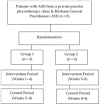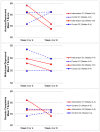Does Hydrotherapy Impact Behaviours Related to Mental Health and Well-Being for Children with Autism Spectrum Disorder? A Randomised Crossover-Controlled Pilot Trial
- PMID: 31952323
- PMCID: PMC7013415
- DOI: 10.3390/ijerph17020558
Does Hydrotherapy Impact Behaviours Related to Mental Health and Well-Being for Children with Autism Spectrum Disorder? A Randomised Crossover-Controlled Pilot Trial
Abstract
Background: Children diagnosed with Autism Spectrum Disorder (ASD) are less physically active than typically developing children due to reduced socialisation and delayed gross-motor skills, negatively impacting social, emotional and physical well-being. This study aimed to determine whether hydrotherapy influences behaviours which impact mental health and well-being in children with ASD.
Methods: A within-subjects, randomised crossover-controlled pilot trial was used over 8 weeks. Children aged 6-12 years and diagnosed with ASD (n = 8) were randomly allocated to Group 1 (n = 4) or Group 2 (n = 4). All children participated in hydrotherapy intervention from either weeks 1 to 4 or weeks 5 to 8. The Child Behaviour Checklist (CBCL) measured behaviour changes impacting mental health and well-being, administered at weeks 0, 4 and 8.
Results: No observable differences were found in CBCL subscales between Group 1 or 2 at baseline (week 0). Paired-samples t-tests revealed significant improvements post-intervention: Anxious/Depressed subdomain (p = 0.02) and the Internalising Problems Domain Summary (p = 0.026), with large effect size (d = 1.03 and d = 1.06 respectively). Thought Problems (p = 0.03) and Attention Problems (p = 0.01) both significantly improved post-intervention. The Total Problems score significantly improved post-intervention (p = 0.018) with a large effect size (d = 1.04).
Conclusion: Hydrotherapy may enhance behaviours impacting mental health and well-being of children with ASD and could be considered a beneficial therapy option.
Keywords: Autism Spectrum Disorder; Child Behaviour Checklist; behaviours; hydrotherapy; physiotherapy.
Conflict of interest statement
The authors declare no conflict of interest.
Figures





References
-
- Association A.P. Diagnostic and Statistical Manual of Mental Disorders (DSM-5®) American Psychiatric Pub; Washington, DC, USA: 2013.
Publication types
MeSH terms
LinkOut - more resources
Full Text Sources
Medical

